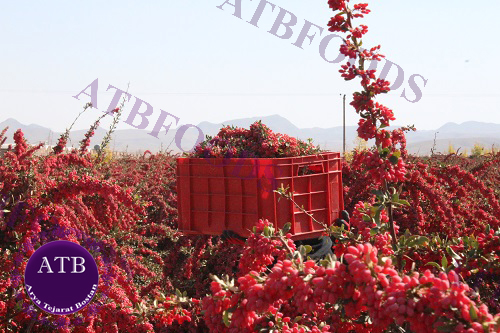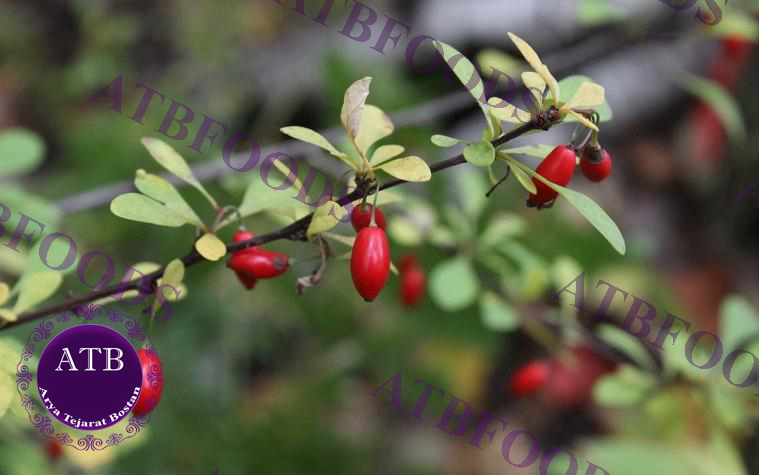Barberry is best harvested when its color ranges from bright red to dark red, and its taste is sweet and juicy. Harvesting barberry is a one-time process, and if early autumn rains do not occur, the harvest time can be delayed to achieve optimal fruit quality in terms of taste. Unripe fruits are extremely sour and somewhat astringent. In some years, problems arise during the drying process of barberry due to early autumn rains, leading to spoilage or damage to the product. Therefore, to avoid the undesirable effects of these early rains, barberry farmers usually harvest it earlier than the ideal time.

Barberry Tree Specifications
The barberry tree typically starts yielding fruit from the second year onward. It has sharp thorns that make harvesting a labor-intensive and challenging process. Barberry is a low-water-demanding plant (requiring irrigation every 7 days in the first year and every 14 days from the second year onwards). During harvesting, care must be taken to prevent the fruit from coming into contact with early autumn rains. In Khorasan, barberry fruit is harvested from late August to mid-December, and it's crucial to harvest it quickly to avoid exposure to frost, freezing, and autumn rains.
Due to the thin skin of the fruit and the abundance of thorns and dense branches in the shrub, harvesting is one of the most challenging and costly stages of barberry production. Currently, various harvesting methods are employed, including hand picking (cluster picking), impact cutting (harvesting by striking branches), branch cutting (cutting branches carrying fruit clusters), a combination of methods (a combination of branch cutting and impact), and mechanical harvesting systems.
Buy Best Iranian Barberry in Whole
Types of Barberry Harvesting Methods

Cluster Picking Method:
- In this method, workers pick individual fruit clusters by hand, placing them in baskets or wooden boxes for transportation to the drying area. However, due to the presence of thorns alongside each cluster, this method is time-consuming and requires skilled labor to handle the task. On average, a worker can harvest about 20-24 kilograms of fresh barberries per day with 8 hours of work. Despite its challenges, this method produces barberries of good quality.
Impact Harvesting Method:
- This method is suitable for large orchards with tall trees where manual harvesting is nearly impossible. Cloth sheets are spread under the trees, and workers use long, relatively thin sticks to strike the branches, causing the fruits to fall onto the spread sheets. The harvested fruits are then transferred to an open space or under the roof for drying. Afterward, the barberries need continuous turning to some extent to dry, and in the next stages, natural air currents and a check (a wooden tool similar to a four-pronged rake specifically for barberries) are used to separate dry leaves from the product. The remaining thorns on the barberries are separated using electric threshing machines, resulting in a clean product.
Disadvantages of Impact Harvesting:
The impact harvesting method can lead to the breakage of young branches that produce the highest yield the following year. This method also causes a significant loss of leaves and creates cracks in the fruit skin due to the impact of fruits with sharp thorns and branches. As a result, the excretions from the cracked fruits can be transferred to healthy fruits, leading to stickiness, dust absorption, and ultimately a decrease in product quality.
Branch Cutting Method with Pruners:
- In the branch cutting method, branches are cut using pruning shears, and the remaining product is placed on wooden or metal beams in covered places such as special storage areas and covered outdoor spaces for about two months to air dry.
Using electric ventilation systems can shorten the drying time in storage areas. After drying, by shaking the branches, high-quality dried barberries, known as puffed barberries, are obtained. These command higher prices in the market.
Combined Method:
- In this method, fruit-bearing branches are initially cut using pruning shears, and the remaining product is then harvested by the impact method.
Mechanical Harvesting System for Barberry:
- This method involves the use of shaking machines to vibrate the main trunks, causing the fruits to fall onto collector frames covered with tarpaulin or canvas. Another approach is the use of overhead harvesting machines that move along the rows, carrying out the harvesting of fruit-bearing shrubs with short trunks.
Next is the use of shaking systems, and this system was tested by designing a simple device at the Scientific and Industrial Research Organization of Khorasan in three stages for mechanical harvesting of seedless barberry. Mechanical harvesting using a pull system, after treatment with atefon, is easier, and the harvested product is more suitable for processing.
In the Qaenat region, barberry is often harvested using traditional methods. At the beginning of the season, when some orchard trees are ripe, they are usually harvested for fresh consumption using the cluster picking method. Some farmers with extensive orchards and tall trees who aim to reach the market quickly harvest their barberry by striking the branches in their orchards using the impact method. They spread it out in large heaps for sale after a month, mainly as the early-season barberry, and most use a combined method of branch cutting and impact to have both fresh and dried barberries.

Barberry Plant Distribution
The barberry plant has been known since the 7th century AD, and its emergence geologically dates back to the Eocene epoch. However, it was introduced in the 8th century AD, and barberry grows in all temperate regions of the Northern Hemisphere. In Iran, both seeded and seedless varieties of barberry are found in regions such as Khorasan, around Tehran, parts of Azerbaijan, Isfahan, Kerman, and between Karaj and Chalous. The seedless variety, known as Zereshk-e Polooyi, is mainly cultivated in the Khorasan region. Barberry orchards are also present in Isfahan. There is a well-known barberry garden near Si-o-Se Pol in Isfahan called the "Zereshk Bagh." While the seeded barberry is mostly grown for ornamental purposes, the seedless variety is commercially significant.
Suitable Temperature:
The vegetative growth of the barberry plant occurs at temperatures between 18-15 degrees Celsius, typically starting in the months of March and May. Barberry flowering occurs in temperatures of around 23-19 degrees Celsius, and the fruit appears. At temperatures of about 11-7 degrees Celsius, the dormant or hidden life cycle of the plant begins. Barberry is resistant to long winters and remains dormant until temperatures rise to around fifteen degrees Celsius.
As observed, temperature changes have a significant impact on the plant's life cycle.
Suitable Soil and Land:
Factors such as soil type, soil pH, the amount of salts present in the soil, irrigation, mineral nutrition, and other environmental factors also affect the plant's life cycle.
The most suitable growth and development conditions for barberry are observed in limestone soils with loamy texture, loamy-sandy, or even sandy-loamy soils. The plant can tolerate soil with a pH of around 9. Barberry grows well in light limestone soils and is somewhat tolerant of water and soil salinity, tolerating soil salinity up to an electrical conductivity (EC) of about 5.5 milliSiemens. The plant has better growth and higher yield in soils rich in necessary nutrients, but it is also relatively resistant to soil nutrient deficiency.